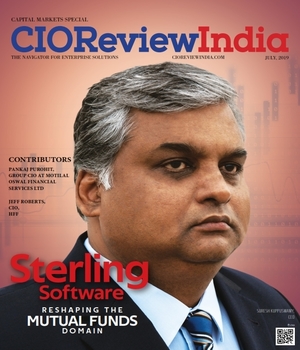
The Fundamental Transformation from Purchase to Procurement
Vinod Mathur, Sr.Director- Strategic Services, JDA Software | Thursday, 22 June 2017, 05:39 IST
 In the recent years and decades, there is a paradigm shift in the buying function worldwide. As global supply chains become linked, there is a realization that all businesses in a value chain are interlinked. The shift is to start looking at not only one's internal supply chain, but the entire value chain that starts from the base raw material to the end consumption. One entity in this value chain can outperform the rest for some period of time, but that is usually not sustainable. This is because a complete focus on one entity's outperformance creates inefficiencies in other pockets of the value chain and that would ultimately hit the whole chain.
In the recent years and decades, there is a paradigm shift in the buying function worldwide. As global supply chains become linked, there is a realization that all businesses in a value chain are interlinked. The shift is to start looking at not only one's internal supply chain, but the entire value chain that starts from the base raw material to the end consumption. One entity in this value chain can outperform the rest for some period of time, but that is usually not sustainable. This is because a complete focus on one entity's outperformance creates inefficiencies in other pockets of the value chain and that would ultimately hit the whole chain.
Let us take an example of a consumer electronics value chain (e.g. cell phones), where an OEM may be focused on procuring the electronic components as late as possible to reduce their liabilities. The semiconductor manufacturing lead times are typically in the range of 6-12 weeks, whereas the component orders by the OEM may get firmed up only 2-4 weeks in advance. This pressure from both sides then translates into executional stress for distributors/manufacturing service providers. Some one in the chain ends up holding risk inventory (for variability and obsolescence risk) to as sure that operations run smoothly. This stress also exists on the retailer side where there are tough negotiations on who bears the financial risks between the OEM and the retail channel.
"The sharing of information can start with basic one-way visibility to a mature collaboration process"
As business matures and stabilizes, organizations understand the dependencies of each other's financial well-being and collaboration models emerge between a buyer and seller. This is the start of the transformation from purchase to procurement. There are many models that talk about the maturity of procurement function. At a fundamental level, this transformation happens on 3 different dimensions.
1. Internal Consolidation
In many large geographically spread corporations, procurement function tends to be very decentralized. It has been observed that different sub-units end up negotiating with the same suppliers for the same parts. While the ownership can continue to be decentralized, centralized or hybrid, the important aspect is to enable a common procurement platform inside the corporation and consolidate the total requirements. Such a platform helps create a comprehensive requirement internally and also helps standardize parts and specifications. This rationalization adds a significant value to both the buying and selling organizations.
The other sub-dimension is the derivation of the overall volume requirement. Simple as it sounds, many buyers still do their own volume forecasting independent of the finished goods demand. An important element of the transformation is linking the raw material requirement forecast to the finished goods demand. There would be reasons to consolidate or pre-buy certain raw material like commodities due to price fluctuations or build safety inventory, but the key is the visible linkage of raw material requirements to the finished goods sales plan.
2. Visibility and Collaboration
Everyone can benefit from a peek into the future. And the same is true for the suppliers. They want to know what is the outlook for the parts supplied by them. What are the buying company's short to mid-term plans? These answers can help the suppliers plan their current capacities and future investments better. This is now getting accepted at more and more procurement organizations. The sharing of information can start with basic one-way visibility to a mature collaboration process.
In a mature collaboration process, the entire operations run as one team with near real time visibility into constraints and inventory status. This helps make the value chain operate smoothly with lean inventory levels.
3. Sourcing and Development
Strategic transformation in procurement comes from creating a sustainable vendor network base. The maturity journey starts with supporting vendors with procurement share or minimum support. This helps provide a steady demand for the suppliers to grow and sustain their business. More mature procurement organizations also work on investing into identified suppliers’ capacity building.
Innovation on this dimension is limitless and is evolving. A major innovation in this area has come in through embedding social sustainability in business. There are many stories worldwide like ITC's Social and Farm Forestry Initiative in Bhadrachalam where the local communities have become vendors and significantly benefitted along with the company.
These principles of procurement can also be applied to newer technology procurement too. For example, there is a lot of co-innovation happening in the space of enterprise software, IoT where the vendors and manufacturing companies are coming together to jointly define evolution of these technologies. This is helping the companies get the benefits of the new technology and popularize it to build an ecosystem for interoperability. At the same time, it allows the technology company to build products/services that can give them additional revenue and a business model to sustain.
These are exciting times in the procurement space with a whole lot of possibilities open to transform not just the function but the entire business and the value chain. It remains to be seen how fast companies can transform and create a better business ecosystem with lesser wastage of time and material.
CIO Viewpoint
BSE - Traversing the Cycle of Continuous...
By CIOReviewIndia Team
Enabling Financial Inclusion on a Digital Platform
By Manoj Kumar Nambiar, Managing Director and Arvind Murarka, Head IT at Arohan Financial Services (P) Limited
Key Tech Trends for Capital Markets
By Dipak Rout, Head-IT, ArihantCapital Markets Ltd
CXO Insights
By Supriyo Dasgupta, IT Applications Head, Compass Group India
The T Minus 10 Of AI - Getting Started with the...
By Sushil Kumar Tripathi, AVP - Technology, Kellton Tech
Digitization in Insurance Industry



.jpg)
.jpg)






